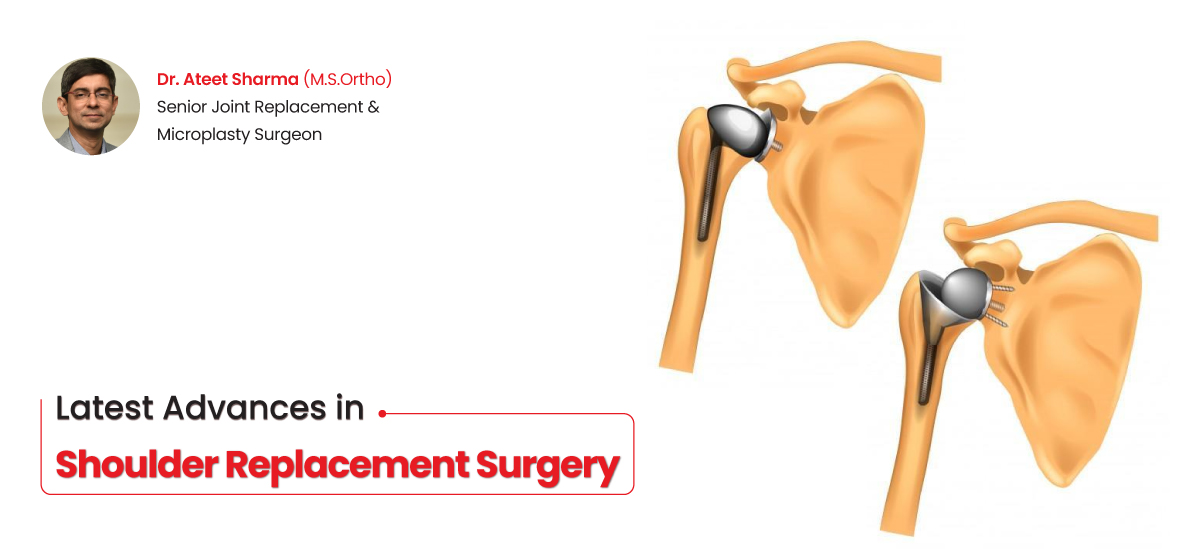
Think back to the days when shoulder replacement surgery meant weeks and weeks of painful healing and a reduced ability to move. Fast forward to our present day, and the entire story flips. But thanks to breakthroughs such as reverse shoulder replacements, 3D-printed implants, and robotic-assisted surgeries, the definition of a successful shoulder replacement has been redefined.
They enable patients to return to work, school, or play sooner with less pain and more confidence. Read on to learn about recent advancements in Shoulder Replacement Surgery in Ahmedabad, or you can visit Dr Ateet Sharma to get more in-depth information. He will assist you with the benefits of advanced shoulder replacement surgery and how this can affect your overall movement.
Talking about the blog, we are going to look at the most recent advancements that have changed how a shoulder can be replaced, achieving outcomes that we could not previously imagine.

Shoulder replacement surgery is often recommended for people with advanced-stage arthritis, severe injury, or chronic pain that limits their use of the joint. Furthermore, in most of these cases, the shoulder joint wears out to a point where conservative treatments such as therapy or medication just simply can not repair the issue. Replacement of the damaged joint with an artificial one can enhance shoulder function and reduce discomfort to the next level.
However, the previous traditional shoulder replacement surgery had its limitations. Along with the procedures and technological advancements, the surgeries have become less invasive, and recovery times have decreased as results improve. Here is an overview of the breakthroughs that are turning it into a better surgery for the future.
One of the Greatest developments in shoulder surgery is reverse shoulder replacement. Because they are founded on the anatomical principles of the shoulder, traditional shoulder replacements are not suitable for every patient with rotator cuff injury. By reversing the position of the ball and socket—creating a form of reverse shoulder replacement, other muscles can step in to provide that lifting function when the rotator cuff is not functioning.
Large incisions were necessary for shoulder replacement surgery in the past, which typically resulted in longer recovery times and more pain. The treatment is now conducted with smaller incisions or less intrusive techniques, causing less damage to nearby organs and tissues. Overall, these treatments help to reduce post-surgical discomfort, damage, and recovery time. Minimally invasive shoulder replacement surgery frequently uses smaller incisions than open surgery procedures. As a result, many patients who have this type of surgery can resume their activities more rapidly.
By using these advanced techniques and preparing for shoulder replacement surgery in the right way, a few of the complications are minimized, such as infection or blood clotting. Because having smaller incisions, there are fewer opportunities for bacteria to enter the body during surgical procedures.
Robotic-assisted surgery represents one of the most exciting breakthroughs in shoulder replacement. Using this most advanced technology, surgeons can perform the surgery with surgical precision. A robotic arm helps the surgeon implant the artificial joint with high levels of precision so that the alignment forces are perfectly executed.
Robotic shoulder replacement surgery leads to fewer problems, more durable implants, and more reliable patient outcomes. This is especially useful for people who have multiple joint problems or may eventually require live shoulder replacements. Robotic surgery is specific to each patient, ensuring the optimal fit and functionality of the artificial joint.
Another development that is changing the field of shoulder replacement surgery is the use of 3D printing technology to produce implants that are anatomically based. In the past, doctors used implants with standard sizes, which might not have been a perfect fit for the patient's bone. Additionally, utilizing 3-dimensional printed implants that fit the patient's shoulder, surgeons create a prosthetic joint for the patient. This results in a more natural movement, which makes the fit more comfortable and durable.
Given previous failures, customization to meet specific anatomic anomalies may be especially useful for 3D-printed implants in less predictable shoulder replacement operations.
The components used in shoulder replacement implants have also improved significantly in recent years. Traditional implants were constructed of metal and plastic, which could weaken over time. The most recent materials, such as ceramic coatings and strongly cross-linked polyethylene, are more durable and resistant to wear, allowing the implant to endure longer.
In light of these developments, recovery from shoulder replacement surgery is now quicker and more comfortable than before. The majority of people can return home the same day or the next after surgery, and physical therapy can begin as early as one week. Robotic technology reduces complications after the operation and recovery times for low-risk shoulder surgery, allowing patients to resume normal activities sooner.
Structured physical therapy soon after surgery improves shoulder strength, mobility, and flexibility. With the help of a physical therapist, the majority of patients can regain full shoulder function four to six months following surgery.
Advances in shoulder alternative surgical treatment have been some of the most significant developments of recent years. Recent advances include robotic-assisted operations and 3D-printed implants, all of which aim to make the treatment safer, easy to use, and more efficient. Patients now have access to advanced options and technology that can result in faster recovery, better outcomes, and permanent relief of shoulder discomfort.
If you've been battling shoulder problems and are thinking of surgery, ask Dr Ateet Sharma about what advances have come with technology in Shoulder replacement surgery. And with all of these modern advances, you can return to the activities that are important to you without the pain.
© 2025 Dr.Ateet Sharma All rights reserved. | Manage by Nexus